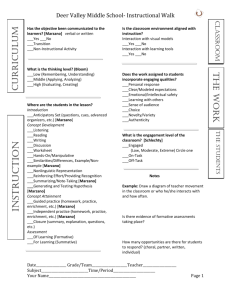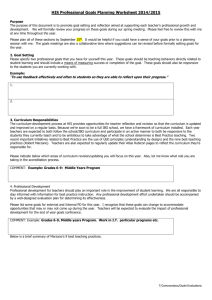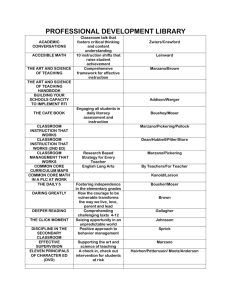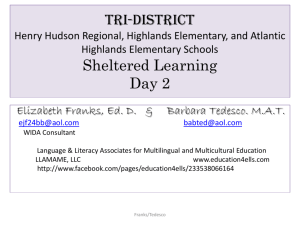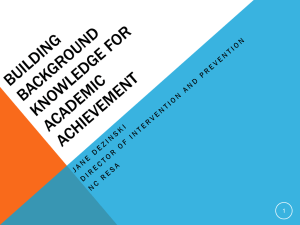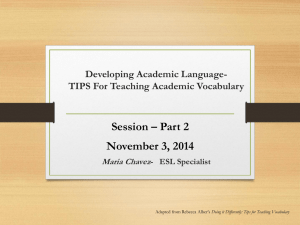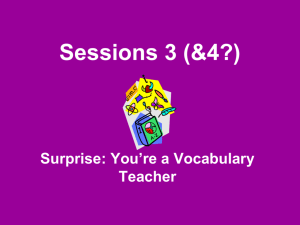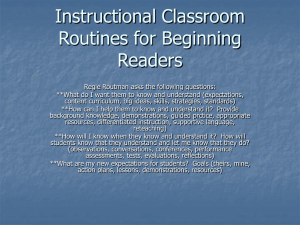Sheltered Instruction, September 2014
advertisement
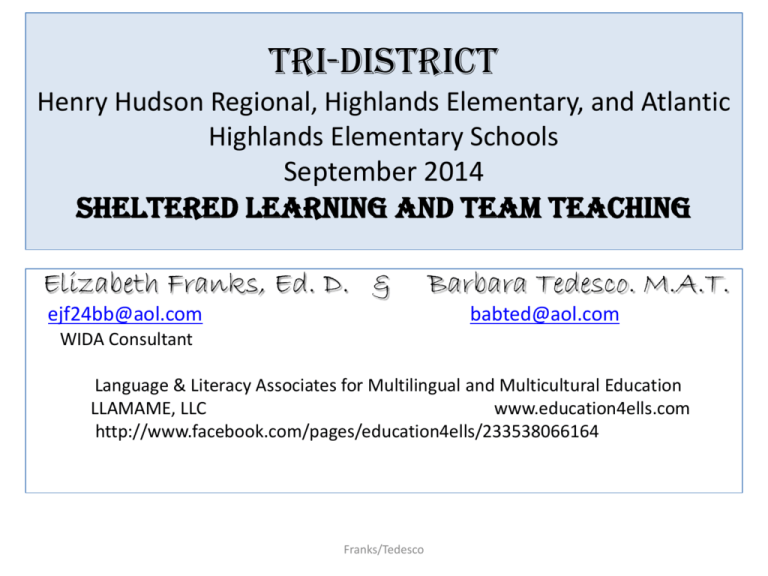
Tri-District Henry Hudson Regional, Highlands Elementary, and Atlantic Highlands Elementary Schools September 2014 Sheltered Learning and Team Teaching Elizabeth Franks, Ed. D. & ejf24bb@aol.com Barbara Tedesco. M.A.T. babted@aol.com WIDA Consultant Language & Literacy Associates for Multilingual and Multicultural Education LLAMAME, LLC www.education4ells.com http://www.facebook.com/pages/education4ells/233538066164 Franks/Tedesco Parking Lot 1. Write down anything that you have a question about without putting your name on the paper. 2. Stick it on the sheet labeled “Parking Lot” at any time of the day. 21st Century Back Channel 1. Tweet 2. Ask questions, share ideas and make comments to class website. Equality vs. Equity Objectives Participants will: Content Language • using language strategically to empower Academic Language Learners (ALL) • explain the importance of including content and language objectives in lessons for ALLs • recognize the value of tapping into students’ background knowledge and building on it • identify ways to co-teach and collaborate • discuss the difference between content and language objectives • Compare and contrast different approaches to coteaching OUR WORDS/PHRASES • • • • • • • Academic Vocabulary Strategic Vocabulary Language Objectives Scaffolds Student Engagement Formative Assessment Collaboration Two Cents Discussion In order to share you must “put in your two cents.” You may not share a second time until everyone has put in their two cents. • What are some factors that contribute to using academic language strategically? Activity: Think-Write-PairShare What is the difference between a content objective and a language objective? Content vs. Language Objectives Content Objectives What you will learn: Language Arts Math Science Social Studies World Languages Visual & Performing Arts Health/Physical Education Computer/Technology Technical Subjects 21st Century Skills Language Objectives How you will use: Listening Speaking Reading Writing in your learning and Consider: Linguistic Complexity Language Forms and Conventions Vocabulary Usage What do you notice about language usage and conceptual knowledge? • https://www.youtube.com/watch?v=CACQmia U6CU Background Knowledge Academic Language • Quick write: What constitutes academic language? Activity Turn to a partner. Person A is the one with the longer hair and the other is Person B. Person A will speak first and person B will write what person A says trying to capture the entire sentence. Social Studies • In social studies, long sentences with multiple embedded clauses are common. • Cause and effect statements are frequent. – Because there will be more people in the world in the future, we will need more land on which to build towns and cities. • Various verb forms are used: – “I found Rome a city of bricks and left it a city of marble.” Augustus is supposed to have spoken these words as he lay dying. He was Rome’s first emperor, and started the first of its great building programs. He claimed that he had had over 80 temples rebuilt. • Frequent use of pronouns it and they as referents. Mathematics • Comparatives: – 6 is greater than 4 – Maria earns six times as much as Peter – Lin is as old as Roberto • Prepositions: – (divided) into, divided by, – 2 multiplied by 6 and X exceeds 2 by 7 • Passive voice: – X is defined as a number greater than 7. Reversals: The number a is five less than b • • Logical connectors: if…then – If a is positive then -a is negative.\ K- How many objects would there be if we added one more?” 1st - Bella added a number to 11 and got 17. What number did Bella add to 11? 3rd - Write a word problem about sharing beads, where 32 ÷ 4 tells the number of beads that were shared. Science Scientific inquiry = asking questions; cause and effect, analysis and comparison Nominalizations serve as subjects or objects (refraction, condensation) Multiple embedded clauses Text structure is dense and hierarchical LOTS of passive voice Adapted from Jeff Zwiers 2008 Language Arts • Reading, writing, speaking, grammar and interpreting literature • Connected to cognitive skills: interpretation, persuasion, cause/effect – Interpretation • Characterization and symbolism • Figurative language, dialogue, plot twists – Persuasion • Culturally-based • Language of persuasion- modals – Cause and effect • Motives for character actions • Author’s purpose and craft Academic Language “Academic language refers to the abilities to construct meaning from oral and written languages, relate complex ideas and information, recognize features of different genres and use various linguistic strategies to communicate.” Dutro & Moran, 2003 Components of Academic Language Bricks: vocabulary Mortar: Grammar/syntax/ form Foundation: Language functions Zwiers, 2008 Language Functions and Examples of Forms Language Function Examples of Language Forms Expressing needs and likes Indirect/ direct object, subject/ verb agreement, pronouns Describing people, places, and things Nouns, pronouns, adjectives Describing spatial and temporal relations Prepositional phrases Describing actions Present progressive tense, adverbs Retelling/relating past events Past tense verbs, perfect aspect (present and past) Making predictions Verbs: future tense, conditional mode Asking Informational Questions Verbs and verb phrases in questions Activity • Making an appointment Language Register$ 1. Frozen-- Language that does not change; remains fixed Examples: Pledge of Allegiance to the Flag; Preamble to the Constitution 2. Formal--Complete sentences and specific word usage. This is the standard for work, school, and business. Examples: Academic Interviews, academic language in classroom (lectures, instruction— mini-lessons), public speaking. 3. Consultative--Formal register used in conversation Example: Talking to a boss/supervisor/teacher, lawyer, doctor, Counselor (asking for assistance) 4. Casual/Informal--Language used in conversation with friends. Word choice is general, and conversation is dependent upon non-verbal assists. Examples: slang (writing drafts should allow casual before the formal draft because it “gets the information out” on the paper) 5. Intimate--Language between lovers as well as the language between twins. This is also the language of Sexual Harassment (not for public information) This list is adapted from a list in the book A Framework for Understanding and Working with Students and Adults from Poverty (Copyright, 1995, Ruby K. Payne, RFT Publishing) Three types of support http://www.state.nj.us/education/modelcurriculum/ela/ Sensory Graphic Interactive Realia Visuals Timelines Graphic organizers Charts Pair Small group Video Hands-on Use of L1 Media Language Objective Function Topic Domain Outcome Support Let’s review …..Chunk & Chew The _ _ _ _ _ _ _ _ objective consists of: • Language _ _ _ _ _ _ _ _ • _ _ _ _ _ _ _ topic •______ • _ _ _ _ _ _ _ (scaffolded for levels 1-4) • _ _ _ _ _ _ _ differentiated by _ _ _ _ _ With Buddy clock appt. Building Background • Concepts explicitly linked to students’ background experiences • Concepts explicitly linked between past learning and new concepts • Key vocabulary emphasized Concepts explicitly linked to students’ background experiences • • • • Stand up-sit down KWL Survey (think technology) May have to provide background experience to connect to lesson - videos/DVDs, streaming, experiments, stories, (virtual) field trips, games, etc. Importance of Vocabulary Instruction • Vocabulary Gap – Gap in word knowledge persists though the elementary years. (White, Graves, & Slater, 1990) – The vocabulary gap between struggling readers and proficient readers grows each year. (Stanovich, 1986) – After the primary grades, the “achievement gap” between socioeconomic groups is a language gap. (Hirsh, 2002) • One of the most persistent findings in reading research is that students’ vocabulary knowledge is related strongly to their reading comprehension and to other overall academic success (Lehr, Osborn, & Hiebert, 2004) Importance of Vocabulary Instruction • Vocabulary Gap Meaningful Differences in Cumulative Experiences (Hart & Risley, 1995, 2003) 3 year-olds Words heard per hour Working vocabulary Below poverty level 616 525 Working Class 1,251 749 Professional 2,153 1,116 Quantity of vocabulary • @ 40,000 by the time of high school graduation • @3,000 per year • 180,000 word families • 3,000 most frequent words account for @ 75% of words in adult texts • ELs (current and long term) need to learn more words, need more powerful instruction and need assistance with word-learning strategies. Vocabulary Tiers Second Tier First Tier • Highest frequency • Words - essential to understanding all content words used for area texts; targeted to everyday speech instruction • Simple multiple • Appear frequently across meaning words domains; polysemous /multiple meaning • Words needed for academic conversations and explanations • Complex idioms • Cognates (true/false) • Homonyms (cell/sell) Third Tier • Lowest frequency • Words needed to understand the content concept • Specific to the content • Likely not to encounter in a lifetime There are no lists for tiers 1, 2, 3. Each group of students will be different based on difficulty of words and background knowledge of student Beck, McKeown & Kucan (2002) ; Foldable - Ogden Polysemous/Multiple Meaning Words Eighty-five percent (85%) of the most often used words have multiple meanings Word: Division Setting/Situation Math Meaning Government Biology Military Business (actually has 11 meanings) Today’s Purpose How do students acquire and extend their academic vocabulary across the school day? Intentional Instruction: Words are identified by Subject and/or grade level. 5 4 3 2 1 Words are identified using a framework for selection. Word lists include general, specialized, and technical vocabulary and are shared across grade levels. All grade levels select a range of general, specialized, and technical vocabulary by subject, but these are only shared within the grade level. Some words have been selected by grade level and subject, although these are driven by textbook lists (primarily technical vocabulary). Individual teachers are applying a framework for selecting vocabulary, although these are not being shared outside of the grade level. Individual teachers have identified words using the textbook (technical vocabulary), and these are not known to others in the grade level and school. Today we will look more closely at how we select vocabulary as a school. The Problem: Too Many Words! • 17 words identified in 2 paragraphs • Ideal is 8–10 a week for deep teaching (Scott, Jamieson-Noel, and Asselin, 2003) • Must be narrowed, but how? Conceptually Complex Continuum Imageability Easy: Dinosaur, pencil Concreteness Concrete: eggs, run Somewhat: prevent, abandoned Somewhat: expensive, peered Not image-able: spirit, promise, merely Abstract: Indeed, era Adapted from Diane August 2014 NABE Relatedness Few networks have low relatedness: lion Dense networks have high relatedness: economy Questions for Selecting Vocabulary 1. Representative 2. Repeatability 3. Transportable • Is it critical to understanding? • Will it be used again? • Is it needed for discussions or writing? 4. Contextual Analysis 5. Structural Analysis 6. Cognitive Load • Can they use context to figure it out? • Can they use structure? Is it a cognate? • Have I exceeded the number they can learn? Adapted from Graves, 2006; Nagy, 1988; Marzano & Pickering, 2005 Using Word Lists to Identify Vocabulary • Dolch Sight Word List (Grades K–3) • Ogden’s Basic English Word List (Grades K–4, and English learners of all ages) – Dreamed of a “universal language” – 850 phonetically regular words • Word Part Lists (Grades 3–6) – Focus on prefixes, derivations • Academic Word List (Coxhead, 2000)(Grades 5–6) – 570 headwords from textbooks Marzano’s Approach • Adopt a district or building – based template • Develop a vocabulary list by grade/content When do you “know” a word? Write Round Robin Meaning Spelling Pronunciation Derivations Connotations Register Collocations Intentions Idioms Antonyms/Synonyms Use of Imagery Some nonlinguistic representations: • making physical or graphic models • generating mental pictures • drawing pictures and pictographs • engaging in kinesthetic activity Quick Draw Marzano’s Six Step Vocabulary Strategy Present students with a brief explanation of the new term or phrase. Present students with a nonlinguistic representation of the new term or phrase. Ask the students to generate their own explanations or descriptions of the new term or phrase. Ask the students to create their own nonlinguistic representation of the term or phrase. Periodically ask students to review the accuracy of their explanations or terms. Play games with vocabulary Vocabulary Map: Frayer Model Essential characteristics Nonessential characteristics New vocabulary term Examples Non-examples 4-Corners Vocabulary: Mind Map and Visual Aid Word: Picture: opals Word in context: Definition: In Coober Pedy, Australia, Beautiful stones, called miners dig opals from under gems, used to make jewelry. the ground. Vocabulary Notes Format Word Meaning Example Sentence Oral Practice glacier Large white ice block or ice mountain The glaciers near the North and South poles are melting. Glaciers are larger and colder than ________ Vocabulary Knowledge Rating Chart Rating Scale: 1= I don’t know it at all. 2= I’ve seen it or heard it before. 3= I think I know what it means, but I could use a review. 4= I know it well and I could easily teach it to the group. Target Word juxtaposed detritus hubris ambiguous What I think it means: Rating Before Rating After Anticipation Guide: Comprehension of Vocabulary Agree or Disagree Dyad _____ 1. SIOP is a protocol to use for ELLs. _____ 2. A parking lot is a strategy for students to post what they learned . _____ 3. CALPs take two years to develop. _____ 4. It is too time-consuming to bring realia into lessons. Word Generation transport import portion portfolio important portage Portland port-a-potty report export portmanteau -port Which of these words are related to the meaning of the root-port? More ideas and games… • Charades, Scattergories, Outburst, Password, Taboo, Pictionary • Crossword puzzles • Collocation puzzles: – Family __(tree) 1. ancestry map – tree_ ________ 2. Commercial forest – _______ ________ 3. cow – _______ _________ 4. John Belushi movie – _______ _________ 5. _______ ____ ____ Sort-List-Group-Label People King George III Colonists Sons of Liberty British Indians Places Boston Harbor England Taxes- foods tea sugar Taxes - Other Stamps Newspapers Paint glass Tax Acts Sugar Act Stamp Act Townshend Revenue Act Quotes “Tax the tea” “Like a giant teapot” “Lobsters” “No taxation without representation” Categorize • Human Word Sort • Review your list and categorize: – Multiple meanings – Interdisciplinary – Word analysis (affixes, nominalizations, etc.) Four Part Vocabulary Program • • • • Provide rich and varied language experiences Teach individual words Teach word learning strategies Foster word consciousness Graves (2006) Using Context With your partner, discuss a definition of the underlined words using the context of the sentence. 1. The crocodile is worthy of admiration in that it is extant. 2. The hardstand must be replaced. It is simply so damaged that it is now dangerous. 3. Haploids are less likely to mutate. 4. Given the time period, Cervantes was forced to lucubrate in order complete his work in a timely fashion. 5. Disguised in mufti, the man shocked the crowd when he pulled a gun. (Carrigg, 2006) Vocabulary Activity A Mardsan Giberter for Farfie Gils was very fraper. She had denarpen Farfie’s mardsan. She didn’t talp a giberter for him. So she conlanted to plimp a mardsan binky for him. She had just sparved the binky when he gibbled in the gorger. “Clorsty mardsan!” she soffed. “That’s a croustich mardsan binky,” soffed Farfie. “But my mardsan is on Stansan. Agan is Kelsan.” Carrigg, 2006 TEACHING VOCABULARY TO BUILD KNOWLEDGE Targeting depth of word knowledge Multiple planned exposures High utility academic words Direct instruction & word learning strategies Lesaux, 2013 Anchored in text Scaffolds • Quick write Write your definition of scaffolding and an example. TRR placemat Scaffolding Quick write Write your definition of scaffolding and provide an example. Identify whether your examples were verbal, procedural or content-based. Share with a partner. Verbal Procedural Content NJDOE Model Curriculum • http://www.state.nj.us/education/modelcurri culum/ela/ • http://www.state.nj.us/education/modelcurri culum/math/ Numbered Heads Together • Number each participant in the group. • Discuss what you do or would do that makes effective co teaching. • Put your heads together to share your ideas. • Call on one number to share one of the stories. Co-teaching is like a …. because… • Choose one of the four symbols of NJ. • In your group, brainstorm and create a simile or a metaphor to complete the statement. Ticket Out Place your “Ticket Out” on the poster board upon leaving. • Today I gained a better understanding of…… OUR WORDS/PHRASES • • • • • • • Academic Vocabulary Strategic Vocabulary Language Objectives Scaffolds Student Engagement Formative Assessment Collaboration Objectives Participants will: Content Language • using language strategically to empower Academic Language Learners (ALL) • explain the importance of including content and language objectives in lessons for ALLs • recognize the value of tapping into students’ background knowledge and building on it • identify ways to co-teach and collaborate • discuss the difference between content and language objectives • compare and contrast different approaches to coteaching Websites • • • • • • • http://www.funbrain.com/idioms http://www.brainpop.com/ http://www.i-ready.com I-Ready offers an adaptive diagnostic, and both teacher-led and individualized online instruction for a complete blended learning solution.(lexile level) www.readingquest.org Clock Buddies http://www.fresno.k12.ca.us/divdept/titlevii/discourse.pdf Discourse Patterns http://www.choiceliteracy.com/articles-detail-view.php?id=1329 Patricia Cunningham and word walls http://www.readwritethink.org many ideas http://www.vocabularya-z.com/ by content and by tiers http://www.learninga-z.com with lesson plans http://lexfiles.info/14-words.html The 14 Words that Make All the Difference http://streaming.discoveryeducation.com/ http://spanishcognates.org http://www.jeffzwiers.com/acalang.html Lexile.com Edugame- software and game wands .K-12 math, LA, Science, and Social Studies Kathy Schrock's Guide for Educators - Fry's Readability Graph …school.discoveryeducation.com/schrockguide/fry/fry.html - Cached – Similar Websites (continued) • http://www.teachervision.fen.com/graphicorganizers/printable/6293.html (Graphic Organizers) • http://www.thinkingmaps.org/ • http://www.proteacher.com/020014.shtml (Strategies) • http://www.emints.org/ethemes/resources/S00000729.shtml (Instructional strategies) • http://www.readingrockets.org/strategies/reciprocal_teaching/ Reciprocal Teaching • http://www.nwlink.com/~donclark/hrd/bloom.html Bloom’s Taxonomy • http://www.USi.edu/distance/bdt Bloom and Technology • http://www.aps.edu/rda/documents/resources/Webbs_DOK_Guid e.pdf by Depths of Knowledge by Norman L. Webb • http://www.paffa.state.pa.us/PAAE/Curriculum%20Files/7.%20DOK %20Compared%20with%20Blooms%20Taxonomy.pdf • http://www.thedailycafe.com/public/2340.cfm Cafe strategies Websites (continued) www.edutopia.org/blog/teaching-ccss-critical-vocabularymarilee-sprenger http://quizlet.com/latest http://www.englishcompanion.com/pdfDocs/academicvocab.pd f Vocabulary by Jim Burke http://www.heinemann.com/shared/onlineresources/e00464/a ppendix.pdf by Jim Burke, a sampler http://www.commoncoreconversation.com/elaresources.html#sthash.zr0d9tYm.dpbs Jim Burke and vocabulary http://www.brighthubeducation.com/special-ed-inclusionstrategies/4096-co-teaching-and-different-styles-of-co-teaching/ http://www.cehd.umn.edu/TERI/Coteaching/Foundations/What.html http://www.teachhub.com/effective-co-teaching-strategies References • Beck, I, McKeown, M, & Kucan, L, (2002). Bringing Words to Life: Robust Vocabulary Instruction. NY: Guilford Press. • Beck, I, McKeown, M, & Kucan, L, (2002). Creating Robust Vocabulary: Frequently Asked Questions & Extended Examples NY: Guilford Press. • Fisher, D., Frey, N & Williams, D.(2002). Seven Literacies Strategies that Work. Educational Leadership, 60(3), 70-73. • Fisher, D. Frey, N. (2008). Word Wise Content Rich: Five Essential Steps to Teaching Academic Vocabulary. Portsmouth: Heinemann. • Fisher, D., Rothenberg, C., Frey, N. (2007).Language Learners in the Classroom. Urbana: NCTE. • Frey, N., Fisher, D. (2009). Learning Words Inside & Out. Portsmouth: Heinemann. • Graves. M., August, D., Mancilla-Martinez, J. (2013). Teaching Vocabulary to English Language Learners. New York: Teachers College Press. • Hiebert, E.H., & Lubliner, S. (2008). The nature, learning, and instruction of general academic vocabulary. In A.E. Farstrup & S.J. Samuels (Eds.), What research has to say about vocabulary instruction (pp.106-129). Newark, DE: International Reading Association. References • Honigsfeld, A., Dove, M. (2010). Collaboration and Co-Teaching. Thousand Oaks, CA: Corwin. • Marzano, R. ( 2004). Building Background Knowledge for AcademicAchievement: Research on What Works in Schools. • Marzano, R. (2010). Teaching Basic and Advanced Vocabulary. Boston: Heinle. • Marzano, R. and Simms, J. (2013). Vocabulary for the Common Core. Bloomington: Marzano Research Laboratory. • Nash, R. (1997). NTC’s Dictionary of Spanish Cognates. Chicago: Il: NTC Publishing Group. • Overturf, B., Montgomery, L., Smith, M. (2013). Word Nerds: Teaching All Students to Learn and Love Vocabulary. Portland: Stenhouse. • Rutherford, P. (2010). Meeting the Needs of Diverse Learners. Alexandria, VA: Just Ask Publications. • Sprenger, M. (2013). Teaching the Critical Vocabulary of the Common Core. Alexandria: ASCD • Wilfong, L. ( 2013). Vocabulary Strategies that Work: Do This-Not That. Larchmont: Eye on Education
